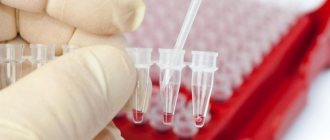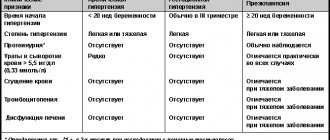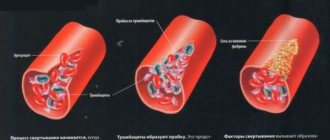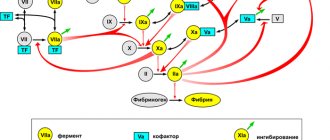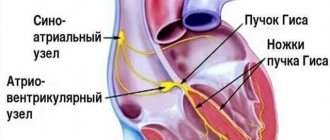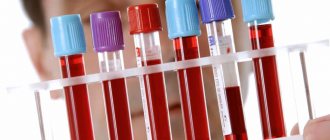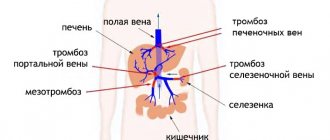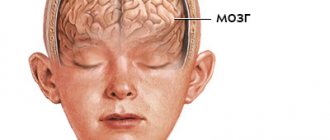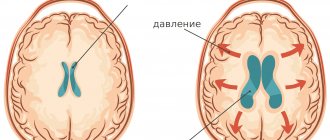Local therapist
Burnatskaya
Svetlana Nikolaevna
33 years of experience
Local therapist, occupational pathologist. Member of the Russian Scientific Medical Society of Therapists
Make an appointment
Disseminated intravascular coagulation, or DIC syndrome for short, is a disease associated with impaired formation of blood clots due to depletion of the corresponding components in the blood. Additional symptoms of the disease include a tendency to bleeding, thrombosis and impaired blood microcirculation in the internal organs, which leads to their dysfunction and exhaustion.
Causes
The disease is secondary in nature and is invariably a consequence of the pathology of the hemostasis process. Among the reasons causing the appearance of obvious symptoms are:
- complications of infectious and inflammatory diseases;
- heavy bleeding;
- consequences of a prolonged state of shock;
- intravascular hemolysis caused by transfusion of the wrong blood type to a patient;
- long-term treatment with drugs that increase the viscosity and rate of blood clotting;
- complications during childbirth - manual separation of the placenta, embolism (entry into the lungs) of amniotic fluid in a newborn;
- complications of cancer.
The risk group for this disease includes patients with low levels of antithrombin III in the blood, elderly people, patients with erythrocytosis and chronic pathologies: pyelonephritis, diabetes mellitus, etc.
Disseminated intravascular coagulation syndrome (DIC syndrome)
Disseminated intravascular coagulation syndrome (DIC) is a condition characterized by disturbances in the blood coagulation system. In this case, depending on the stage of DIC, multiple thrombi (blood clots) form in the vessels of various organs or bleeding occurs.
The blood coagulation system includes platelets and coagulation factors (specific proteins and inorganic substances). Normally, blood clotting mechanisms are activated when there is a defect in the vessel wall and bleeding. As a result, a thrombus (blood clot) forms, which clogs the damaged area. This protective mechanism prevents blood loss due to various injuries.
Disseminated intravascular coagulation syndrome occurs against the background of other serious diseases (for example, complications during childbirth and pregnancy, severe injuries, malignant tumors and others). At the same time, a significant amount of coagulation factors is released from damaged tissues, which leads to the formation of multiple blood clots in various organs and tissues. This impedes blood circulation in them and, as a result, causes their damage and dysfunction.
A large number of blood clots leads to a decrease in the number of blood clotting factors (they are consumed during the formation of blood clots). This reduces the blood's ability to clot and leads to bleeding (hypocoagulation stage).
DIC syndrome is a serious complication and threatens the patient's life. It is necessary to carry out urgent therapeutic measures aimed at treating the underlying disease (against the background of which DIC syndrome occurred), preventing the formation of new blood clots, stopping bleeding, restoring the deficiency of coagulation factors and blood components, and maintaining impaired body functions.
Synonyms Russian
Consumption coagulopathy, defibration syndrome, thrombohemorrhagic syndrome.
English synonyms
Disseminated intravascular coagulation, consumption coagulopathy, defibration syndrome.
Symptoms
Symptoms of disseminated intravascular coagulation syndrome depend on the stage of the disease.
At the stage of increased blood clotting, multiple blood clots form in various organs.
With blood clots in the vessels of the heart and lungs, these and other symptoms may occur:
- chest pain (can spread to the left arm, shoulder, back, neck, jaw, upper abdomen);
- dyspnea;
- feeling of lack of air;
- cold sweat;
- nausea;
- vomit.
Signs of blood clots in the veins of the legs:
- leg pain;
- redness;
- heat;
- swelling.
With thrombosis of cerebral vessels, acute cerebrovascular accident (stroke) can develop. He is accompanied by:
- headache;
- loss of consciousness;
- nausea, vomiting;
- speech disorders;
- muscle weakness or immobility of an arm or leg on one side;
- muscle weakness or immobility on one side of the face;
- numbness predominantly on one side of the body.
The formation of blood clots in the vessels of other organs (for example, kidneys) leads to their damage and dysfunction (renal failure).
The amount of blood clotting factors gradually decreases, as they are consumed in the process of forming multiple blood clots. As a result, DIC enters the stage of hypocoagulation (reduced blood clotting). This may cause bleeding.
Symptoms of internal bleeding (into various internal organs and tissues):
- blood in the urine - as a result of hemorrhage in the bladder, kidneys;
- blood in stool – bleeding in the gastrointestinal tract (for example, in the stomach, small intestine);
- severe headache, loss of consciousness, convulsions and other manifestations - with hemorrhage in the brain.
Symptoms of external bleeding:
- prolonged bleeding even from minimal skin lesions (for example, from the injection site);
- bleeding from the nose, gums;
- prolonged heavy menstrual bleeding in women;
- pinpoint hemorrhages on the skin (petechiae).
Thus, the manifestations of disseminated intravascular coagulation syndrome are diverse and depend on the stage of DIC syndrome and the predominant damage to certain organs.
General information about the disease
Disseminated intravascular coagulation syndrome is a disorder in the blood coagulation system that develops against the background of various serious diseases.
The reasons for the development of DIC syndrome may be:
- complications during pregnancy and childbirth (for example, placental abruption, fetal death, severe blood loss and others);
- sepsis is a serious disease in which the infection circulates in the blood and spreads throughout the body;
- severe injuries, burns, in which a large amount of substances from destroyed cells enter the bloodstream, the endothelium (the inner wall of blood vessels) is damaged; these and other mechanisms can cause activation of blood coagulation processes;
- malignant tumors - the mechanism of development of disseminated intravascular coagulation in malignant tumors has not been fully studied; according to researchers, some types of malignant tumors (for example, pancreatic adenocarcinoma) can release substances into the blood that activate blood coagulation processes;
- Vascular disorders – vascular diseases such as aortic aneurysm (an enlargement of a vessel that threatens to rupture) can cause a local increase in coagulation (blood clotting). Once in the bloodstream, activated coagulation factors lead to disseminated intravascular coagulation throughout the body;
- poisonous snake bites.
Thus, these conditions can cause the release of a large number of blood clotting stimulants into the blood, resulting in the formation of blood clots in the vessels of various organs. This can lead to disruption of the blood supply to the lungs, kidneys, brain, liver and other organs. In the most severe cases, severe dysfunction of several organs occurs (multiple organ failure).
Gradually, the level of blood clotting factors decreases, as they are consumed during the formation of blood clots. As a result, the blood's ability to clot is sharply reduced. This may lead to bleeding. The severity of bleeding can vary from small hemorrhages on the skin (petechiae) to massive bleeding from the gastrointestinal tract, hemorrhages in the brain, lungs and other organs.
Disseminated intravascular coagulation syndrome can be acute or chronic. In acute DIC syndrome, after a short phase of hypercoagulation (increased blood clotting), hypocoagulation (decreased blood clotting) may develop. In this case, the main manifestations will be the occurrence of bleeding and hemorrhages in various organs.
In chronic DIC, the formation of blood clots comes to the fore. Cancer is a common cause of chronic disseminated intravascular coagulation syndrome.
Disseminated intravascular coagulation syndrome is a serious complication. According to various researchers, the presence of DIC syndrome increases the risk of death by 1.5 - 2 times.
Who is at risk?
Risk groups include:
- women who have serious complications during pregnancy and childbirth (for example, placental abruption)
- patients with sepsis (a serious condition in which infection spreads through the bloodstream throughout the body)
- persons with severe injuries, burns
- persons with malignant tumors (for example, prostate adenocarcinoma)
- persons who have been bitten by poisonous snakes.
Diagnostics
Laboratory diagnostics play a key role in the diagnosis of disseminated intravascular coagulation syndrome. Determining blood coagulation parameters is also of great importance in the treatment of DIC syndrome. The following laboratory tests are carried out:
- Coagulogram. Analysis of the blood coagulation system. Blood clotting is a complex process involving many components. Assessment of coagulation parameters includes several indicators: APTT (Activated partial thromboplastin time), INR (International Normalized Ratio), prothrombin index, antithrombin III, D-dimers, fibrinogen and others. In case of DIC syndrome, a comprehensive assessment of these indicators is required. Activated partial thromboplastin time (aPTT). Shows the time it takes for a blood clot to form when certain chemicals are added to blood plasma (the liquid part of the blood). An increase in this indicator indicates hypocoagulation, that is, a decrease in the ability of blood to clot (tendency to bleed), a decrease in this indicator indicates an increased risk of thrombosis (formation of blood clots).
- Prothrombin index (PI). Prothrombin is a protein that is produced in the liver. It is a precursor to thrombin, a protein necessary for blood clotting. The prothrombin index shows the ratio of the clotting time of a healthy person's plasma to the clotting time of a patient's plasma. This indicator is expressed as a percentage. An increase in this indicator indicates increased blood clotting; a decrease indicates a decrease in the blood’s ability to form a blood clot.
- International normalized ratio (INR). An indicator of the blood coagulation system. An increase in this indicator is observed with a decrease in the ability of blood to clot. It is an important parameter when treating with drugs that affect the blood coagulation system.
- Antithrombin III. It is a natural substance that reduces blood clotting. During the thrombus formation stage, the amount of antithrombin decreases. Using this indicator, one can indirectly judge the severity of DIC syndrome.
- Fibrinogen. Fibrinogen is a protein that is necessary for the blood clotting process. During the stage of increased blood clotting in DIC syndrome, a decrease in fibrinogen levels is observed.
- D-dimers. D – dimers are one of the end products of the breakdown of fibrinogen (a protein involved in blood clotting). An increase in the level of D-dimers indicates activation of thrombus formation. The level is increased during the hypercoagulation stage of DIC syndrome.
- Thrombin time. The time it takes for fibrin (the protein needed to form a blood clot) to form a clot when an enzyme (thrombin) is added. An increase in this indicator is observed with hypocoagulation (decreased blood clotting ability).
- General blood analysis. This indicator allows you to determine the number of main blood components: red blood cells, hemoglobin, platelets, leukocytes. With DIC syndrome, there may be a decrease in the number of platelets.
Assessment of kidney and liver function:
- Serum creatinine. Creatinine is formed in the muscles and then enters the blood. Participates in metabolic processes accompanied by the release of energy. It is excreted from the body in urine through the kidneys. When kidney function is impaired, the level of creatinine in the blood increases.
- Urea in serum. Urea is the end product of protein metabolism. It is excreted from the body by the kidneys and urine. Urea levels increase when kidney function is impaired.
- Alanine aminotransferase (ALT). Alanine aminotransferase is an enzyme that is found in many cells of the body, mainly in liver cells. When liver cells are damaged, this enzyme enters the blood. An increase in the level of this enzyme is observed with liver damage.
Research:
Diagnosis of DIC syndrome is based on clinical data and laboratory tests. Various studies may be necessary to diagnose the underlying disease and complications that have arisen. The need for and scope of research is determined by the attending physician.
Treatment
Treatment tactics for disseminated intravascular coagulation syndrome depend on the causes of its occurrence, the severity of the patient’s condition and other factors.
Acute disseminated intravascular coagulation syndrome is a serious condition that threatens the patient's life and requires intensive treatment measures. Treatment can be aimed at eliminating the causes that caused DIC syndrome (the underlying disease), preventing the formation of blood clots in the vessels, stopping bleeding, restoring the normal volume of blood and its components. To do this, transfusions of fresh frozen plasma (the liquid part of blood taken from a donor), blood components, intravenous administration of various solutions, drugs that affect blood clotting, and other medications can be used.
Prevention
There is no specific prevention of disseminated intravascular coagulation syndrome.
Recommended tests
- Coagulogram No. 3 (PI, INR, fibrinogen, ATIII, APTT, D-dimer)
- Thrombin time
- General blood analysis
- Serum creatinine
- Urea in serum
- Alanine aminotransferase (ALT)
Literature
- Dan L. Longo, Dennis L. Kasper, J. Larry Jameson, Anthony S. Fauci, Harrison's principles of internal medicine (18th ed.). New York: McGraw-Hill Medical Publishing Division, 2011. Chapter 116. Coagulation Disorders. Disseminated Intravascular Coagulation.
- Mark H. Birs, The Merk Manual, Litterra 2011. Chapter 17, p. 694. Disseminated Intravascular Coagulation.
Symptoms
Among the signs of DIC syndrome are:
- rapid blood clotting even with minor cuts or injuries;
- numerous external and internal bleeding;
- formation of blood clots in blood vessels;
- bleeding in the lungs, stomach or nose;
- the appearance of bruises and bruises on the skin;
- drop in blood pressure;
- fatigue, general deterioration of the body;
- the appearance of wheezing and extraneous sounds in the lungs when breathing.
Thrombosis: when is it normal and when is it abnormal?
Throughout life, a person receives various injuries, ranging from minor scratches to serious wounds. The body has its own defense mechanism aimed at stopping the bleeding. To do this, it begins to coagulate in the damaged area, forming a blood clot.
In general, the body has two systems that have radically opposite purposes. One system is called coagulation, and the second is called anticoagulant. If they work without any disturbances, then balance is maintained in the body. When a threatening situation arises, such as an injury, the blood clots, preventing massive bleeding. In the absence of any damage, the blood is in a liquid state.
In order for a blood clot to form at the site of vessel damage, the body must initiate many complex reactions. They involve a protein called fibrinogen, which is present in the blood plasma, as well as platelets, a clotting factor and various enzymes. As a result, the resulting clot closes the defect on the vascular wall and prevents blood from flowing out.
If damage to the vessel does not occur, then the blood circulates through the vessels in a liquid state, preventing blood clots from forming. Antithrombotic mechanisms are responsible for this, which are carried out thanks to substances called anticoagulants. These include plasma proteins, endogenous heparin and proteolytic enzymes. If fibrinogen begins to accumulate in one place or another of the vessel, then the rapid flow of blood “breaks” it and a blood clot does not form. This mechanism is called fibrinolysis. It also involves enzymes that produce leukocytes, platelets and other blood cells. Small fibrin particles will simply be destroyed by macrophages and leukocytes in the future.
If there is a failure in certain hemostatic systems, or a person develops any disease, the mechanisms that regulate the functioning of the coagulation and anticoagulation systems fail. At the same time, blood clots begin to form in the body, increasing the risk of massive bleeding. It is these disorders that underlie the development of DIC syndrome. They are extremely dangerous to human health and pose a threat to life.
Complications
In the absence of timely treatment and additional exposure to negative factors, the patient may experience:
- intoxication of the body;
- thrombohemorrhages;
- hepatic-renal failure;
- hemorrhagic shock;
- the appearance of signs of secondary bleeding.
In a third of complicated cases, DIC causes death.
Forms and stages
The following criteria for DIC syndrome are currently accepted:
- acute form - occurs due to sepsis, blood transfusion, trauma or surgery. Lasts from several hours to several days;
- subacute form - lasts several weeks, develops against the background of autoimmune and chronic infectious diseases;
- chronic form - can be observed for several years, caused by complex heart diseases, pathologies of blood vessels, lungs or kidneys, as well as diabetes;
- recurrent form - occurs after completion of treatment, may have varying severity;
- fulminant form - develops within a few minutes, is associated mainly with complicated childbirth;
- latent (hidden) form – has blurred signs, which makes diagnosis difficult.
Diagnostics
The clinical picture plays an important role in making a diagnosis. With serious damage to internal organs, the diagnosis is obvious. But in subacute and chronic forms, the symptoms are not so bright.
In addition to the clinical picture, clinical research data are important to establish a diagnosis:
- general blood test;
- general urinalysis;
- coagulograms (testing blood for clotting);
- blood smear analysis;
- enzyme immunoassay (search for possible infections).
- Internal organs are also examined for damage.
Treatment
To cope with the consequences of the disease you can:
- a course aimed at eliminating the main provoking factor or disease that caused increased blood clotting;
- plasma transfusion (transfusion therapy);
- saline injections;
- a course of polyglucin and albumin solution;
- intravenous administration of heparin.
Clinical recommendations for DIC symptoms depend on the age, general condition of the patient and the main diagnosis that caused the hemolytic disorders.
